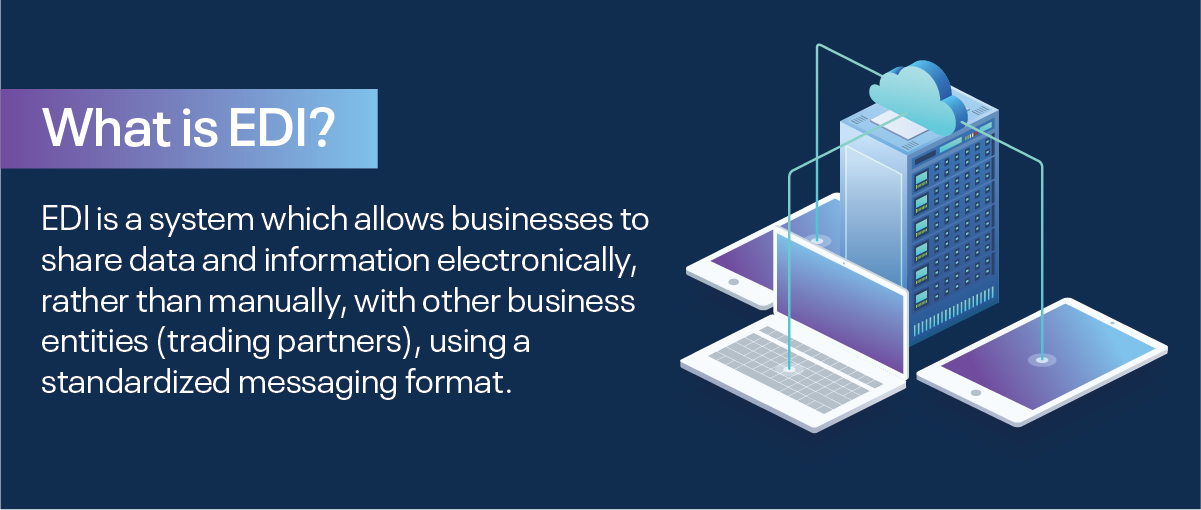Other recent blogs


Let's talk
Reach out, we'd love to hear from you!
Born in the second era of Information Technology, EDI (Electronic Data Interchange) is playing an incremental role in the age of Digital Transformation. At a time, when API (Application Programming Interface) is gaining traction among businesses, for facilitating the exchange of valuable data with utmost security, EDI which is older than API, has managed to keep up its relevance intact and that too with prominence. Reports tell that although some of the world’s renowned businesses such as Wal-Mart, HarperCollins, Hallmark Cards, JCPenney, and more rely on EDI, approximately 41% of businesses are yet to explore its potentials.
There are innumerable myths surrounding EDI, today, and therefore, it is essential to unravel the facts so that businesses can reap optimum benefits. Before we proceed to demystify the myths clouding EDI technology, let’s know more about it.
Introduction to Electronic Data Interchange

When Edward A. Guilbert, the father of EDI, developed the Electronic Data Interchange system in the 1960s, it was a major breakthrough in electronic data transmission. In the later years, as the requirement and demand grew, EDI standard formats such as TRADACOMS,EANCOM, EDIFACT, X12, RosettaNet, ebXML, and more were developed. These formats not only make Electronic Data Interchange feasible and useful for innumerable industries such as retail, healthcare, shipping, airline, transportation, supply chain, logistics, and many more but also provide a standard platform for successful B2B (Business to Business) messaging.
Myths and Facts of EDI
If you believe that the demand for EDI Solutions is glacial, you need to rethink. Reports suggest that approximately “80-90% of the business-to-business traffic” is due to EDI. Even after such positive results, many businesses are hesitating to initiate EDI integration or adopt EDI technology because of the myths surrounding the EDI system. Let’s go through some of the common myths and reveal facts that would help businesses embrace EDI technology and reap benefits.
Myth #1: Costly
EDI integration and implementation is assumed to be a costly endeavor for its dependency on VAN (Value Added Network) to deliver messages. This is why businesses think that the EDI technology offers little Return on Investment (ROI).
Fact:
These days, EDI can be delivered by a number of secure methods such as AS2 (Applicability Statement 2) or SFTP (Secure File Transfer Protocol). These communication methods are economical, secure, and flexible than VAN. Initially, handling data transactions manually involved a lot of costs, but after automating the paper-based tasks, the EDI technology helps in reducing cost per transaction.
Myth #2: Expert Skills Needed; Difficult to Understand
In any business, the Electronic Data Interchange is considered to be an evolving solution. When a business grows and starts trading with partners, the complexity of the EDI grows as well. In such cases, understanding the data transacted through the EDI technology requires an expert.
Fact:
- EDI integration helps streamline key business practices, which translates into better communication. There was a time when collecting, processing, and mapping individual data coming in from multiple sources required high levels of expertise as well as hundreds of man-hour. However, today, high-end expertise is not needed. There are tools and technology-led processes that make it seamless and add speed and precision too.
- With frequent revisions of EDI standard versions such as X12, EDIFACT, and other EDI standards recognized by ANSI, the clarity, portability, and ability to relate with the evolving transactional systems such as ERPs and CRMs have improved.
Myth #3: Loss of Control; Speed of Business Processes Slows Down
It’s a common misconception that the implementation process of an Electronic Data Interchange interferes with your business practices, slowing down the speed of regular business processes and loss of control.
Fact:
- EDI significantly helps in increasing productivity as it automates the tasks such as data entry, analysis, and processing and takes comparatively less time for implementation and generates higher ROI.
- Electronic Data Interchange does not need manpower to process paper documents, making transactions flow faster. Having automated the tasks, EDI not only adds speed and accuracy but also give enterprises better control over the business data. This enables your supply chain to redirect man-hours to critical business processes.
Myth #4 - Handling Large Data Volumes is Complex with EDI
Trading with multiple partners increases the volume of data transactions and also the business information that you share with their system. This impacts your system’s ability to constantly manage how your systems talk to each other. It further compromises data maintainability and security.
Fact:
- EDI solutions are apt to manage large volumes of data. The modern EDI architecture is backed by technology and automation makes everything seamless—right from data collection to successful transaction of data with customers, suppliers, and other trading partners.
- EDI has standardized business-to-business messaging and has undergone a wide range of technical innovations to cater to the data-exchange needs of the modern-day businesses. EDI solutions are also reflecting the sensitivity of modern software solutions including improved interoperability, ease of use, and cost efficiency.
Myth #5: APIs will Replace EDI
EDI is for large businesses with huge volumes of data and a large ecosystem of trading partners. It is not a solution to the problems faced by small and medium enterprises (SMEs). SMEs prefer moving to real-time synchronous transaction models that are more adaptive, such as APIs as they believe that they are a better fit for their business. The setup time and costs are also comparatively lesser.
Fact:
- Major businesses have implemented their integrations with trading partners using EDI. It is also easier for smaller companies and new entrants to adopt EDI, or rather amalgamate EDI standards with modern and secure data transmission mechanisms such as AS4.
- APIs are not well suited for asynchronous transactions or exchange of bulk data but this may change over time.
Why Facts Surpass the Myths?
- Any organization that sells or buys goods or services can potentially use EDI. The reason is that EDI supports the entire business cycle. It streamlines the relationship that companies have with their customers, distributors, suppliers, and so forth.
- Primarily EDI is expected to be used only in the retail, grocery, manufacturing, and financial industries. However, the U.S government is one of the biggest users of EDI.
- EDI has proven to have a plethora of potential benefits. It is a productive medium that is beneficial to both customers and vendors. It is a service to customers and is often viewed as an indicator of technical ability.
- EDI automation improves operational efficiency of business processes, creating opportunities for re-engineering them.
Why EDI is here to stay in the foreseeable future?
Over the last decade, there’s been a conspicuous change in the EDI technology. It is helping businesses transform drastically with the help of additional advanced protocols such as AS2, HTTP (HyperText Transfer Protocol), SFTP, FTP, (File Transfer Protocol) and more. The credit goes to the increased usage of the high-speed Internet, which not only brought freedom from exchanging the B2B data manually but has also made data transmission possible in no time.
Amidst all the twists and turns, the demand for B2B EDI integration is continuously growing. According to a report, by 2025, the EDI market is expected to reach approximately $5.9 billion. Therefore, it can be easily deduced that the Electronic Data Interchange is not dying soon and beyond the myths, this B2B messaging technology certainly has an ebullient future.




